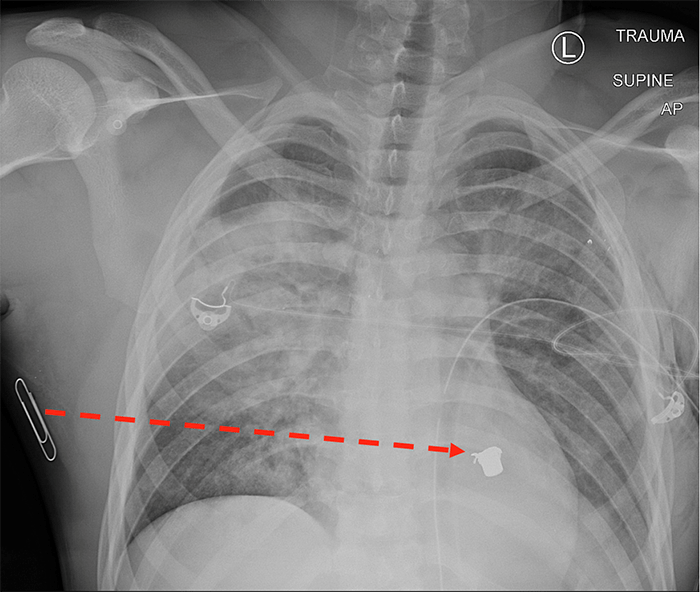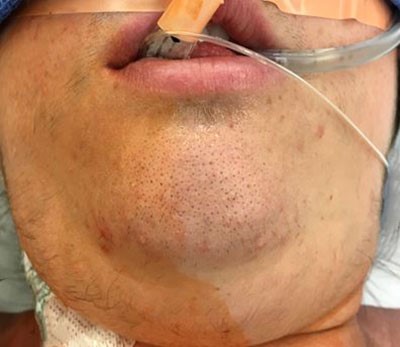Figure 3. Right breast pathology showing intraductal papilloma within fibromatosis
The differential included cellular fibroadenoma v. phyllodes. Due to discordance between imaging and physical exam, an incisional biopsy was performed. Alternatively, excising the palpable 8 cm lesion in the patient's size 34B breast would have created a major deformity without certain improvement in outcome.
Intraoperative findings revealed a firm, irregular mass fixed to the pectoralis major. Pathology revealed fibromatosis with central proliferative epithelium including numerous intraductal papillomas and usual ductal hyperplasia. Cytokeratin studies ruled out metaplastic carcinoma. The mass involved both breast parenchyma and skeletal muscle. Medial, inferior, and posterior margins were positive. CT of the chest, abdomen, and pelvis was negative. Breast MRI revealed one additional fibroadenoma.
The patient was then referred to a medical oncologist and geneticist. The Invitae colorectal cancer panel that was sent only resulted in a variant of unknown significance. After multidisciplinary tumor board discussion, the patient was prescribed sulindac and raloxifene for two to four years or until the lesion became stable. At eight-month follow-up, the tumor was less symptomatic as well as less prominent on physical exam.
Discussion
Fibromatosis, a benign desmoid tumor of the breast, is a rare diagnosis that constitutes less than 0.2 percent of all primary breast tumors. It is a slow-growing, but locally aggressive infiltrating lesion with recurrence rates between 21-57% following surgical excision. It has most commonly been reported in women between the ages of 30-40, although men have been diagnosed as well.1
The etiology of fibromatosis of the breast is unclear, but tumors have been found to arise from both chest wall and mammary tissue. Similarities with other desmoid tumors have raised the question of whether there is a relationship with hereditary syndromes including familial adenomatous polyposis and Gardner's syndrome. Although there are APC/b-catenin pathway alterations, the majority of cases are not diagnosed in the context of hereditary syndromes.2 Further efforts to link the disease processes failed to show similar expression of estrogen and progesterone receptors in breast fibromatosis.3,4 Finally, there have been few reported cases in which trauma, including prior surgery and breast augmentation, is proposed to be a cause of breast fibromatosis.5
Patients typically present with a firm, palpable mass in the breast, occasionally associated with dimpling or retraction of the skin.6 Mammographic imaging may show a suspicious spiculated mass of BIRADS 5, although up to two-thirds of cases are not visualized on mammography. These lesions are also difficult to distinguish on ultrasound. Although MRI is thought to be the most sensitive technique for detecting fibromatosis, even this can be variable and non-specific.7,8
Therefore, fibromatosis of the breast is often difficult diagnose even following clinical and radiographic work-up, and histologically, they appear similar to other desmoid tumors. Their overall composition consists of interlacing fascicles with peripheral entrapment of mammary tissue. The stroma is further collagenized with myxoid tissue as well as blood vessels and lymphoid aggregates. Mitotic activity is low, and atypia is rare, but ductal hyperplasia with and without atypia has been observed.3
To date, no report of intraductal papillomas within the fibromatous tissue, as was present in our case, has been published. While it is not uncommon to find proliferative epithelium along the periphery of the fascicles, central entrapment is rare. In general, intraductal papillomas that are found to be benign on core biopsies are not excised; however, studies show a significant risk of upstaging, especially when multiple or atypical papillomas are found on biopsy. Atypia is associated with a four- to fivefold increased risk of progression to invasive carcinoma.9 We did not excise the papilloma-containing breast fibromatosis in our case given the lack of atypia.
The majority of patients diagnosed with breast fibromatosis have been managed with wide local excision and negative margins.1 However, recurrence rates are as high as 57 percent for patients with muscular involvement and between 21 to 27 percent for patients with solely mammary tissue involvement.8 Rates increase with younger age, positive margins, and tumor size.10 Given the presence of all three factors in our case, in addition to the morbidity of resecting the tumor off the chest wall, we did not feel that a wide local excision would be beneficial.
Our patient was started on sulindac and raloxifene because of their roles in halting and causing regression in extra-abdominal desmoid tumors.11 In addition to lowering breast cancer risk, raloxifene has been shown to be effective in reducing both tumor size and symptoms.12 Radiation and chemotherapy may play a role in treating patients with fibromatosis, but the side-effects make these less desirable for such a young woman.13 On the other hand, tyrosine-kinase inhibitors have shown some promise in increasing disease-free survival in a safe manner, but studies have been small with limited follow-up.14,15
Conclusion
Fibromatosis of the breast remains a rare disease lacking clear and standardized management guidelines. We recommended medical management in our case due to lack of atypia and the high risk of recurrence with excision. The patient has responded well after eight months of sulindac and raloxifene. Our plan is to follow her in our high-risk and medical oncology clinics every three to six months for the first two years, then off medications every 6 to 12 months indefinitely, depending on her course.
Lessons Learned
Fibromatosis of the breast is associated with high recurrence rates following wide excision. Medical treatment with nonsteroidal anti-inflammatory drugs and hormone therapy has been successful; however, patients should continue to be followed closely with imaging.
Authors
Yitian Liu, MD
Cleveland Clinic Foundation, Division of Breast Services, Cleveland, OH
George Thomas Budd, MD
Cleveland Clinic Foundation, Division of Breast Services, Cleveland, OH
Mita Patel, MD
Cleveland Clinic Foundation, Division of Breast Services, Cleveland, OH
Correspondence
Dr. Yitian Liu
9500 Euclid Ave.
Cleveland, OH 44195
347-997-0517
yitianliu1@gmail.com
Disclosure Statement
The authors have no conflicts of interest to disclose.
References
- Matherne TH, Green A, Tucker JA, Dyess DL. Fibromatosis: the breast cancer imitator. South Med J. 2004;97(11):1100-1103.
- Abraham SC, Reynolds C, Lee JH, et al. Fibromatosis of the breast and mutations involving the APC/ß pathway. Hum Pathol. 2002;33(1):39-46.
- Reis-Filho JS, Milanezi F, Pope LZ, Fillus-Neto J, Schmitt FC. Primary fibromatosis of the breast in a patient with multiple desmoid tumors--report of a case with evaluation of estrogen and progesterone receptors. Pathol Res Pract. 2001;197(11):775-779.
- Devouassoux-Shisheboran M, Schammel DP, Man YG, Tavassoli FA. Fibromatosis of the breast: Age-correlated morphofunctional features of 33 cases. Arch Pathol Lab Med. 2000;124(2):276-280.
- McMenamin MEMBMMrcp, DeSchryver KMD, Fletcher CDMMDFrcp. Fibrous Lesions of the Breast: A Review. Int J Surg Pathol April. 2000;8(2):99-108.
- Taylor T V., Sosa J. Bilateral breast fibromatosis: Case report and review of the literature. J Surg Educ. 2011;68(4):320-325.
- Glazebrook KN, Reynolds CA. Mammary fibromatosis. Am J Roentgenol. 2009;193(3):856-860.
- Schwarz GS, Drotman M, Rosenblatt R, Milner L, Shamonki J, Osborne MP. Fibromatosis of the breast: case report and current concepts in the management of an uncommon lesion. Breast J. 2006;12(1):66-71.
- Tatarian T, Lazar M, Sokas CM, et al. Intraductal Papilloma with Benign Pathology on Breast Core Biopsy: To Excise or Not? J Am Coll Surg. 2015;221(4):S20.
- Neuman HB, Brogi E, Ebrahim A, Brennan MF, Van Zee KJ. Desmoid Tumors (Fibromatoses) of the Breast: A 25-Year Experience. Ann Surg Oncol. 2008;15(1):274-280.
- Janinis J, Patriki M, Vini L, Aravantinos G, Whelan JS. The pharmacological treatment of aggressive fibromatosis: a systematic review. Ann Oncol. 2003;14:181-190.
- Tonelli F, Ficari F, Valanzano R, Brandi ML. Treatment of desmoids and mesenteric fibromatosis in familial adenomatous polyposis with raloxifene. Tumori. 89(4):391-396.
- Keus RB, Nout RA, Blay JY, et al. Results of a phase ii pilot study of moderate dose radiotherapy for inoperable desmoid-Type fibromatosis-An EORTC STBSG and ROG study (EORTC 62991-22998). Ann Oncol. 2013;24(10):2672-2676.
- Eastley N, McCulloch T, Esler C, et al. Extra-abdominal desmoid fibromatosis: A review of management, current guidance and unanswered questions. Eur J Surg Oncol. 2016;42(7):1071-1083.
- Scheer L, Lodi M, Moliére S, Kurtz J-E, Mathelin C. Medical treatment of mammary desmoid- type fibromatosis: which benefit? World J Surg Oncol. 2017;15(86).





